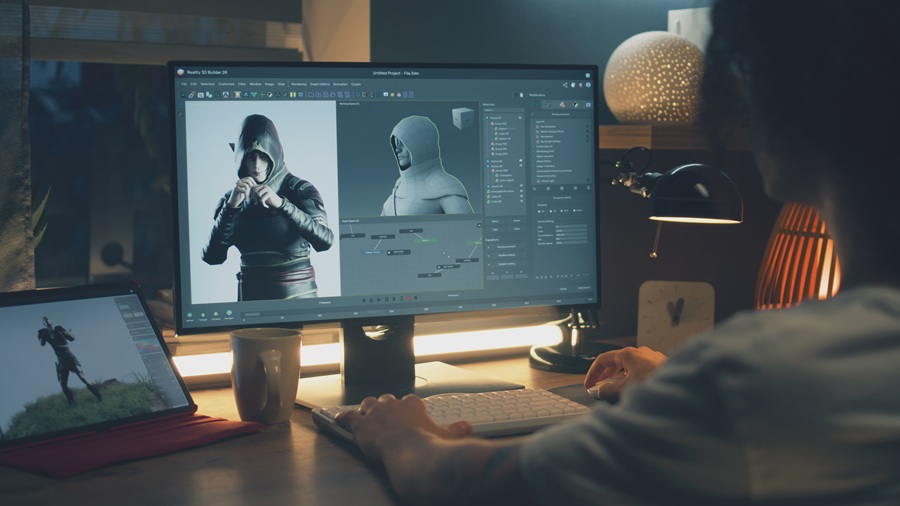When players talk about Game AI, they often jump straight to pathfinding or decision-making. But before an NPC can move or decide, it has to perceive the world.
That’s where perception systems come in, they’re the bridge between raw game data and believable character behavior. Done right, perception creates tension, immersion, and the illusion of intelligence. Done wrong, it turns AI into frustrating cheats or oblivious dummies.
In this article, we’ll explore the foundations of perception, its production challenges, and why thoughtful implementation is key to creating memorable player experiences.
What Do We Mean by “Perception” in Game AI?
Perception systems are how NPCs gather information about their surroundings. In Unreal Engine or custom engines, these typically include:
-
Vision – Is the player in range, in a field of view, and unobstructed?
-
Hearing – Can the NPC detect footsteps, gunfire, or environmental sounds?
-
Environment cues – Smoke, light, or cover changing line of sight.
-
Social perception – What nearby allies or enemies communicate, shaping group awareness.
Unlike raw pathfinding, perception is probabilistic. It’s about awareness levels rather than hard yes/no states. Guards don’t instantly know your location, they “almost see” you, hesitate, and then react. This fuzziness is what sells believability.
Why Perception Is More Than a Checkbox
Too often, teams treat perception as a quick add-on: slap in Unreal’s default system, check the “sight radius” box, and move on. The result? Generic AI that all feels the same.
Real perception requires asking:
-
What should this character care about? (Not every sound matters.)
-
How should awareness build over time? (Spotted instantly vs. gradual suspicion.)
-
How should multiple NPCs share information? (A guard’s shout pulling others into the search.)
This connects perception directly to decision-making and movement. Perception defines what the AI knows, which then guides what it chooses and how it moves.
Classic Example: Fixing the “Raycast Everything” Problem
When I first worked in Game AI, I joined a startup project building squad-based SWAT behavior. The original system raycasted constantly for every NPC, tanking performance.
The fix was simple but effective:
-
Check distance first (is the player even close enough?).
-
Check field of view angle (is the player inside the cone?).
-
Only then raycast — and not just once, but several times to measure partial visibility.
This layered approach gave smooth awareness transitions (“I think I saw something”) instead of binary vision, while also restoring performance to 60 FPS.
Lesson: good perception isn’t about doing everything. It’s about deciding what matters, in what order, and what you can fake.
Beyond Vision: Multi-Channel Perception
The most believable AI uses multiple channels of perception together:
-
Vision + Environment → NPCs lose sight in smoke, or need to open a door before attacking.
-
Vision + Hearing → Guards react to gunfire outside their field of view.
-
Social + Movement → Squad AI doesn’t just see you; it coordinates flanking with teammates.
When channels overlap, you create richer behaviors without bloating your system.
Common Pitfalls in Perception Systems
-
Over-engineering → Dozens of perception checks for things the AI will never use.
-
Under-engineering → Using UE defaults without tuning, leading to robotic or unfair AI.
-
Ignoring optimization → Running constant raycasts or physics checks until FPS collapses.
-
No interpretation layer → NPCs instantly “know” instead of building suspicion.
Good perception balances clarity of design with efficiency of implementation.
Why Perception Matters for AI Design
Perception isn’t just a background system — it’s the core of how AI “comes alive.”
-
It defines awareness → NPCs don’t just exist; they react to what they see, hear, or sense.
-
It shapes decision-making → What an NPC knows directly changes how it chooses actions ([Decision-Making in Game AI](Decision-Making in Game AI: Beyond Behavior Trees)).
-
It makes behavior believable → Suspicion building over time, guards relaying alerts, or enemies investigating noises all create immersion far beyond scripted logic.
The trick is balance: too many perception checks and the game lags; too few and AI feels dumb. The real skill lies in choosing the right signals and tuning them so NPCs respond believably without burning performance.
Social Perception: Coordinating Without a Director
When we think about perception, we usually picture NPCs seeing the player or hearing a noise. But in squad-based or large-scale AI, perception also has to cover social context — what other NPCs are doing.
Instead of relying on an expensive “AI director” that micromanages roles, a smarter approach is distributed:
-
Role awareness → Each NPC perceives which tactical roles are available (flanker, suppressor, breacher).
-
Reservation system → Once an NPC commits to a role, it “reserves” that slot so others don’t duplicate it.
-
Emergent coordination → The squad naturally spreads out, covers doors, or stacks on an entry without global scripting.
This reflects the original intent of blackboard systems — a shared communication space where agents post and read information to coordinate. By contrast, Unreal Engine’s blackboard is most often used as local memory for a single Behavior Tree, not as a medium for multi-agent cooperation.
When used properly, social perception makes squads feel intelligent without brute force. Players don’t see the blackboard; they just see AI that seems to coordinate like a real team.
Thought Leadership: AI That Feels Smart
Here’s the truth: AI doesn’t need to be intelligent — it needs to feel intelligent.
Perception is the trick.
-
A guard hesitating before firing feels smarter than one with instant x-ray vision.
-
A squad spreading out because of social perception feels tactical, even if it’s just weighted path costs.
-
An enemy hearing your footsteps and investigating sells tension, even if the logic is simple.
Too often, indie projects stop at Unreal’s default perception and call it a day. But deeply understanding and expanding perception systems is what makes AI stand out.
Perception isn’t just an input. It’s the experience that convinces players your NPCs are alive.
Closing
Perception is the unseen foundation of Game AI. It’s how NPCs connect the world to their actions, and when designed thoughtfully, it transforms mechanics into memorable encounters.
If your team is struggling with perception, or just relying on out-of-the-box systems, you may be missing the chance to elevate your AI.
Ready to design AI that feels smart, efficient, and tailored to your game? Explore our Technical Expertise in Game AI, Networking, and beyond, and let’s build systems that truly fit your vision.
FAQ: Perception in Game AI
What is perception in game AI?
Perception is how non-player characters (NPCs) gather information about the world and other entities. It can includes vision (line of sight, cones, distance checks), hearing (footsteps, gunfire, explosions), environmental cues (doors, obstacles, smoke), and even social perception (recognizing roles or behaviors of teammates).
Why not just use Unreal Engine’s perception system?
Unreal’s perception tools are a strong starting point, but they’re usually applied “as-is.” Many teams only use them for Behavior Tree state updates instead of designing a deeper perception model. Without customizing stimuli ranges, awareness levels, or communication between NPCs, AI ends up feeling generic instead of tailored to the game’s needs.
How does social perception improve AI behavior?
Social perception allows NPCs to coordinate without requiring a centralized AI director. Each entity perceives available tactical roles (like flanker, suppressor, or breacher), reserves one, and avoids duplicating what others have claimed. This emergent coordination makes squads feel smart and believable while staying efficient.
What’s the difference between awareness levels and simple yes/no checks?
A yes/no system says “the NPC sees the player” or “it doesn’t.” Awareness levels introduce gradation: partial visibility, suspicious movement, or occlusion checks. This creates tension and more natural AI reactions, like guards hesitating or investigating instead of instantly knowing everything.
Can perception systems impact performance?
Yes. Overusing raycasts, line traces, or unnecessary triggers can tank frame rates, especially in large-scale scenes. Smarter design uses layered checks (distance → cone of vision → raycast), optimized queries, and sometimes approximate “fakes” to maintain believable AI without overwhelming performance budgets.
How do perception and movement systems work together?
Perception feeds into movement choices. For example, NPCs may avoid high-danger zones by treating them as high-cost nodes in pathfinding, or they may split roles in squad formations to cover more ground. Combining perception with movement systems makes AI appear tactical rather than mechanical.
Why is perception so important for game immersion?
Players don’t think about raycasts or algorithms. They notice when an NPC almost spots them, when enemies react to noise, or when squads flank in believable ways. Perception is what convinces players that the AI is “thinking,” even when the underlying systems are relatively simple.
What’s next if I want to go deeper into Game AI?
Perception is one part of the bigger picture. You can explore how NPCs make decisions or how they move intelligently. Together, these systems create AI that feels alive and engaging.


